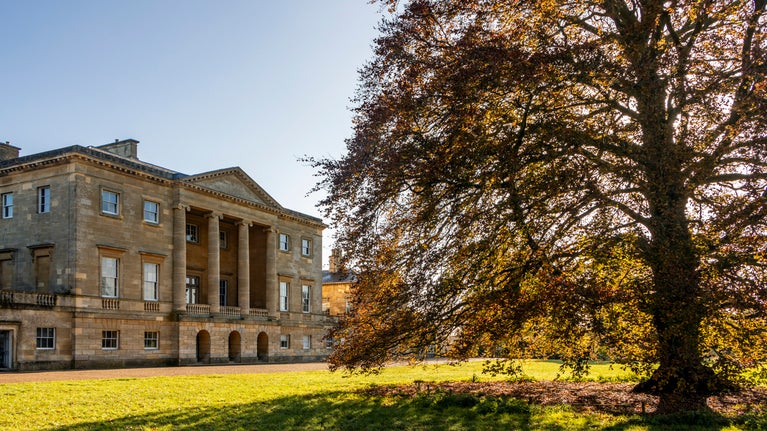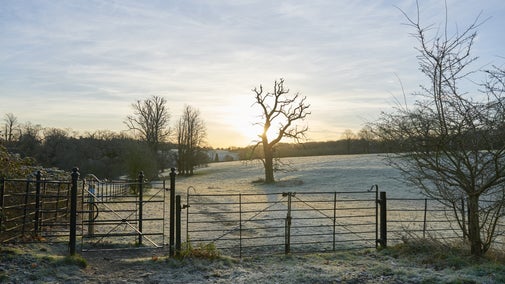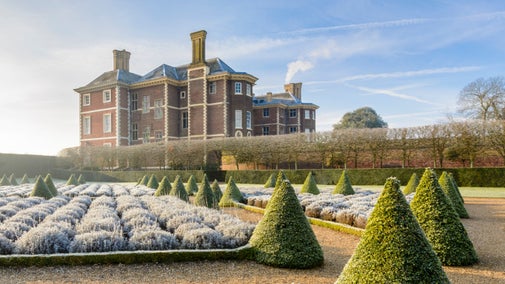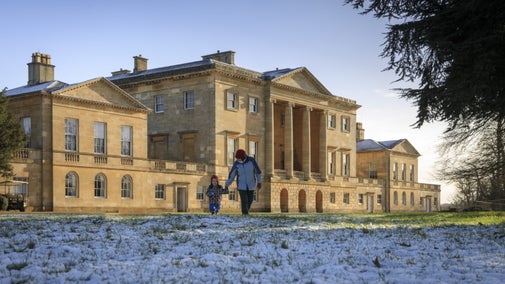
Discover more at Basildon Park
Find out when Basildon Park is open, how to get here, the things to see and do and more.

This 18th-century Bath-stone house was inspired by Italian Palladian architecture. It was saved and lovingly restored by Lord and Lady Iliffe in the 1950s, who brought Basildon Park back to life, acquiring a collection of fine furnishings and carefully selected Old Masters. Explore the richly decorated Neo-classical hall, a spectacular staircase with cantilevered stairs and arched first-floor gallery and an octagonal drawing room with heavily gilded ceilings.
The showrooms on the first floor of the house are open. On busier days, such as weekends, we may use timed tickets which will be first come, first served and can be picked up from Visitor Reception. We cannot guarantee everyone will be able to go inside the house on their visit.
The entrance to the showrooms on the first floor is up a 22-step stone staircase.
On the East Front a distinctive bay in the middle of the house conceals an octagonal room across all three floors.

In the architect’s original plans, the second-floor Octagon Bedroom, now a conservation studio, sits above the Octagon Drawing Room on the first floor, with an octagonal Breakfast Room on the ground floor leading straight out onto the terraced lawn.
The summer Breakfast Room was converted into a billiard room in the 19th century and today it is the Garden Room. This hidden gem is a cool space for quiet reflection, with views out over the parkland where cattle graze among the historic tree clumps.
The walls here were covered in red felt in 1954 where it was put directly over the existing wallpaper. It was put up by Lady Iliffe and her cook and was used instead of more traditional materials like silk damask because of the constraints of rationing. The colour was chosen as it was popular in the 18th century as a background for paintings, and it blends well with the ceiling, providing a richness to the room.
The panoramic wallpaper in the Garden Room is made by the French firm Zuber, which has been hand-printing decorative wallpapers since 1797 and is still making them, using traditional techniques that have changed very little in the last 250 years.
In the 1980s the National Trust bought the Edwardian damask silk curtains that now hang on the wall in the Green Drawing Room from the Benyons, who own Englefield House in Theale. You can tell that they are curtains because there are vertical stripes running down the fabric where the sunlight has discoloured the folds. The curtains were taken apart, stretched and attached to battens to form panels which were then padded and nailed to the walls. They were then trimmed with the original curtain braid.
In 1991–2, artist Alec Cobbe was employed to install the painted roundels in the ceiling and he painted the lunettes in the Dining Room. The content of the original 18th-century roundels was not precisely known so he based the new ones on the roundels in the Music Room at Harewood House, which had been designed by John Carr, the same architect who designed Basildon Park. They feature three of the nine Muses, Erato (poetry), Melpomene (tragedy) and Thalia (comedy) which reflect Lord Iliffe’s literary tastes. Much of the gilding was carried out by Papworth in the 19th century and has only been cleaned and retouched since.
At nearly three metres tall and covering six panels, the Coromandel Screen is an impressive example of Chinese lacquerware. Julie Chang, PhD candidate from UCL, had concluded that the screen was once much larger, potentially up to as many as 12 panels, and that the image on the front depicted the popular legend of An Elegant Gathering in the Western Gardens. Oral archives suggested that the missing six panels had never been at Basildon Park and that the screen had been bought ‘as was’, most likely from one of the London auction houses or property sales in the 1950s or 1960s.
This room, now part of the tea-room, was originally the Servants’ Hall.
Michael Dillon, Lady Iliffe’s nephew, decorated this room in 1999. He painted murals on the walls that were inspired by the ruined city of Angkor Wat, Cambodia. Lord and Lady Iliffe visited Angkor Wat on their journey around the world.
– Michael Dillon, painter
The Iliffes modernised the house, installing central heating, bathrooms and a kitchen. Basildon Park has several bathrooms on the second floor of the house installed by the Iliffes, the Red Bathroom, Lady Iliffe’s Bathroom and the White Bathroom. The Iliffes repurposed small rooms, such as closets, as there was previously only one bathroom for the whole house.
Historically the 1950s kitchen was used as a bedroom by both the Sykes and Morrison families. Originally this room would have been the women’s bedroom. Later, during the Morrisons’ tenure at Basildon, James Morrison and Charles Morrison used this room as their bedroom. Architect JB Papworth would have also improved the ceiling while it was a bedroom, meaning that the ceiling as it stands is quite magnificent for a kitchen.
Lord and Lady Iliffe transformed the room into a kitchen with 1950s fitted storage and an area to prep for the lavish parties the Iliffes held. Ruth Mott, a television cook and personality, worked as a full-time cook at Basildon Park from 1970 to 1987, before becoming famous in her 70s for a TV series where she demonstrated the skills she had developed working in Victorian and wartime kitchens such as Basildon Park. The National Trust re-opened the kitchen to the public in June 2010.

Find out when Basildon Park is open, how to get here, the things to see and do and more.
Follow the rise and fall of Basildon Park from aspirational 18th-century beginnings to its decline after the Second World War and how its fortunes recovered in the 1950s.

Discover the beautifully laid out, restored grounds that surround the house at Basildon Park. Take in the views from the terrace and pause awhile under the thatched Umbrello seat.

Enjoy food and drink and buy a reminder of your day out on your visit to Basildon Park. Pick up a tasty treat in the tea-room or grab a gardening must-have in the shop.

Historic houses and buildings are full of stories, art and collections. Learn more about their past and plan your next visit.

Discover some of the finest country houses and buildings in the country, with fascinating stories to tell of love and money, political intrigue and scandal.
